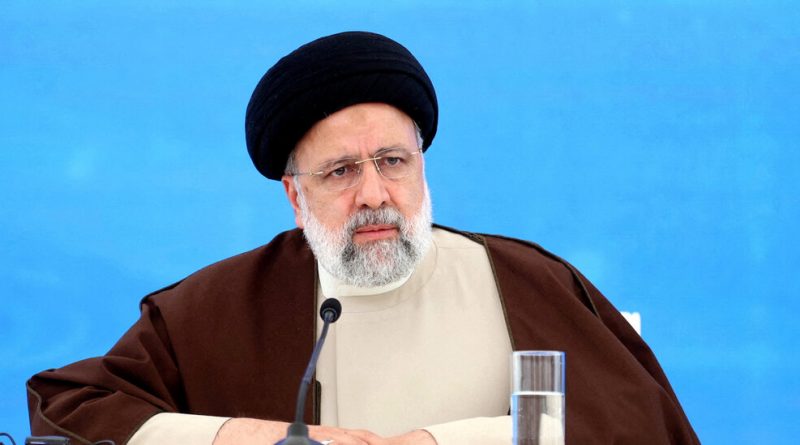Helicopter Carrying Iran’s President Has Crashed, State Media Reports

A helicopter carrying President Ebrahim Raisi of Iran and his foreign minister crashed on Sunday in the country’s mountainous northwest, according to state media, deepening the turmoil that has gripped the nation on both the international and domestic fronts in recent months.
Mr. Raisi, 63, was traveling from Iran’s border with Azerbaijan to inaugurate a joint dam project. The helicopter, carrying Mr. Raisi and Foreign Minister Hossein Amir Abdollahian, state media reported, crashed near the city of Varzaghan around 1 p.m. local time, in bad weather and thick fog.
Search and rescue teams scoured an area of tall mountains and dense forest through rain and fog for more than 10 hours. At one point the authorities called off the aerial search because of the weather, dispatching on foot soldiers, elite commandos of the Revolutionary Guards and 40 rescue teams to locate the crash site.
Even well into the night, state media had not yet reported on casualties, or on the condition of the president or anyone else aboard. The cause of the crash was also unknown.
“There will be no disruption in the country’s operation,” Supreme Leader Ayatollah Ali Khamenei said in an address on state TV. “Senior officials are doing their work and I have advised them on the necessary points and all of the country’s operation will carry on smoothly and orderly.”
Mr. Raisi, a conservative who violently crushed dissent, is widely viewed as a possible successor to the supreme leader. The uncertainty over his fate comes during a particularly tumultuous period for Iran.
Its long shadow war with Israel burst into the open after Hamas attacked Israel on Oct. 7, setting off the war in Gaza and a cascade of strikes and counterstrikes across the region.
The hostilities became even more pronounced after Israel conducted airstrikes on a building in the Iranian Embassy complex in Syria in April. Iran retaliated with its first direct attack on Israel after decades of enmity, launching more than 300 drones and missiles toward the country, many of which were shot down.
Domestically, Iran is also facing widespread anger, with many residents calling for an end to clerical rule. Corruption and sanctions have gutted the economy, stoking frustrations.
In the last two years, the country has witnessed a domestic uprising, the Iranian currency plunging to a record low, water shortages intensified by climate change and the deadliest terrorist attack since the 1979 founding of the Islamic Republic.
Source: Iranian state and semiofficial news agencies
By Charlie Smart and Lauren Leatherby
If the president dies, the vice president takes over and elections must organized within 50 days, said Ali Vaez, the Iran director of the International Crisis Group, an independent conflict prevention agency.
That, he said, would be “a major challenge for a country that is in the midst of a severe crisis of legitimacy at home and daggers drawn with Israel and the United States in the region.”
Mr. Raisi is a hard-line religious cleric who came of age during the country’s Islamic revolution. Under Iran’s theocratic system, Mr. Raisi, as president, is the second most powerful individual in Iran’s political structure after the supreme leader, Mr. Khamenei.
After becoming president in 2021, Mr. Raisi consolidated power and marginalized reformists who wanted to defuse tensions with the West. He repeatedly said that he pursued a policy of “strong diplomacy,” forging closer economic and security ties with Russia and China.
During Mr. Raisi’s tenure, Iran continued to expand its regional influence, backing proxies across the Middle East that have conducted strikes against Israel and the United States, as well as advancing the country’s nuclear program.
In the same period, Mr. Raisi oversaw a sweeping and deadly crackdown on domestic protesters, many of them women and young people, who had taken to the streets against the country’s ruling clerics. Rights groups said hundreds of protesters were killed by the nation’s security forces.
Mr. Raisi has been viewed as one of the front-runners to succeed Mr. Khamenei as supreme leader. One of his main rivals for that role is a son of Mr. Khamenei.
Despite the crash, some analysts said they did not expect a major change in Iran’s agenda abroad.
The nation’s supreme leader is responsible for setting all of the country’s policies, analysts said, while the president’s power comes from enacting those decisions.
“At one level, the outcome does not portend a sea change in how Iran formulates and acts upon its interests abroad,” said Ali Vaez, the Iran director for the International Crisis Group.
“It is the supreme leader who makes strategic decisions about foreign policy, albeit informed by the views of other key stakeholders, including the president.”
Mr. Abdollahian, the foreign minister, has been heavily involved in regional diplomacy with Arab countries. In recent months, he had also met in Qatar with leaders of the militant groups backed by Iran, including Palestinian Islamic Jihad and Hamas, the group that led the Oct. 7 attack against Israel.
He was also engaged in secret indirect talks with the United States, in February and in May, in Oman to discuss defusing tensions and relieving sanctions related to Iran’s nuclear program.
Vivian Nereim contributed reporting.
Source – NY Times




